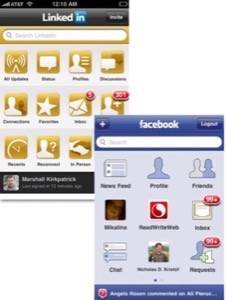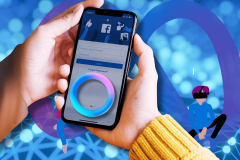Business social network LinkedIn made a major upgrade to its iPhone app tonight but coming from a service with such incredible potential, there remain some major disappointments.

The new app looks a lot like a less elegant, less customizable version of the Facebook iPhone app. There are a variety of useful new features, from faster invite sending to importing contact info to your phone, but the app remains based on the company’s mistaken desire of late to be your all-in-one social-media-messaging platform. It also fails to deliver the features that would make it most useful. If you’re looking for good news about new features, you can find it in the self-flattering company blog post. Here are the three things that disappoint me most about this new app; hopefully it’s a work in progress and will improve soon.

What’s The Most Important Kind of LinkedIn Update? People Getting New Jobs!
For some reason LinkedIn will not deliver you a simple feed of the new jobs that contacts of yours have taken – not by email, not by RSS, not through its fancy new API and not on this new iPhone app. Update feeds are cluttered with imported ephemera from Twitter and all too often job changes are obscured behind the phrase “contact X has updated their profile.” They have? How did they update it? It’s maddening.
LinkedIn says it’s working on solving this problem, but it doesn’t seem to be a very high priority. Prompting users to click more and engage with a wider variety of message types seem more in line with LinkedIn’s strategy. The company clearly wants to be Facebook and Twitter for the business world – not just a place where we all go to find out essential work information that we use while doing other forms of social networking on other sites better suited for things like short, trivial messages.
Importing Contacts to Your Phone is Rudimentary
Perhaps LinkedIn isn’t to blame for this, but the ability to import LinkedIn contacts’ info onto your phone is rendered a whole lot less useful by the inability to merge that info with existing contacts. Say you’ve got someone’s name and phone number on your phone already – it’s a headache to pull in a person’s LinkedIn profile info and then merge the two manually.
Of course your phone number isn’t an optional field you can fill out on LinkedIn, so all those imported contacts will be people you’re unable to call. You won’t even be able to look them up on LinkedIn again from your phone’s contact list – peoples’ LinkedIn profile page URLs aren’t included in the contact info that gets imported.

There’s No Push Notifications
This is a professional application that people use on the iPhone – shouldn’t it include push notifications? LinkedIn is used by tons of sales people, for example – you know they’d like to get some of these updates pushed to them. As a writer, I would too.
Look at it this way. Last month my LinkedIn contact Tara Hunt changed her profile to show that she’s founded a new company called Shwowp. I want to know that, preferably right away. But I don’t know about it until a month later because I didn’t want to fish through a bunch of cross-posted Twitter updates inside LinkedIn to catch Tara’s news, and I didn’t want to click through three screens starting with the bland “Tara Hunt has updated her profile” in order to see if she’s happened to change jobs or just noted a new personal interest on her profile page.
When someone who has accepted my contact request changes jobs, I want a push notification about what the new job is and the option to call them on the phone immediately to discuss it. That doesn’t seem like too much to ask, and that’s when I’ll know that LinkedIn is really serving my professional life.
Update: LinkedIn’s Adam Nash, author of the company’s announcement blog post, responded on Twitter saying: “we’ve discussed all three of these enhancements internally. Some are harder than others. All in the queue…Rest assured, we wouldn’t have broken out profile updates into its own module if we didn’t have big plans for it. :)”





















